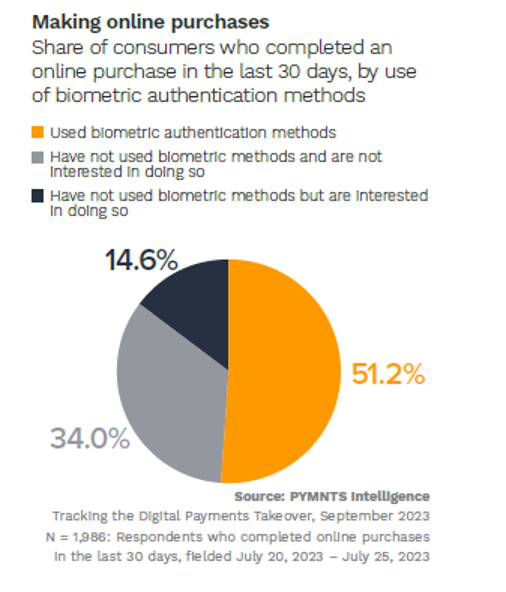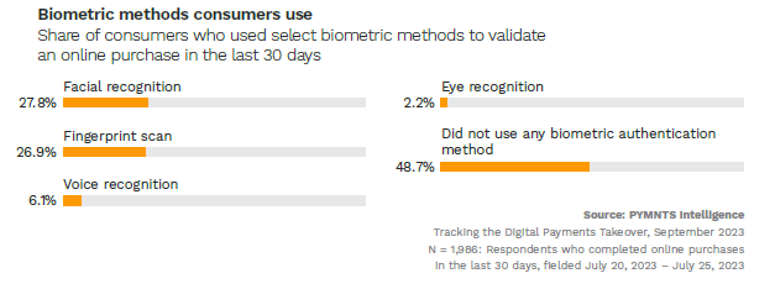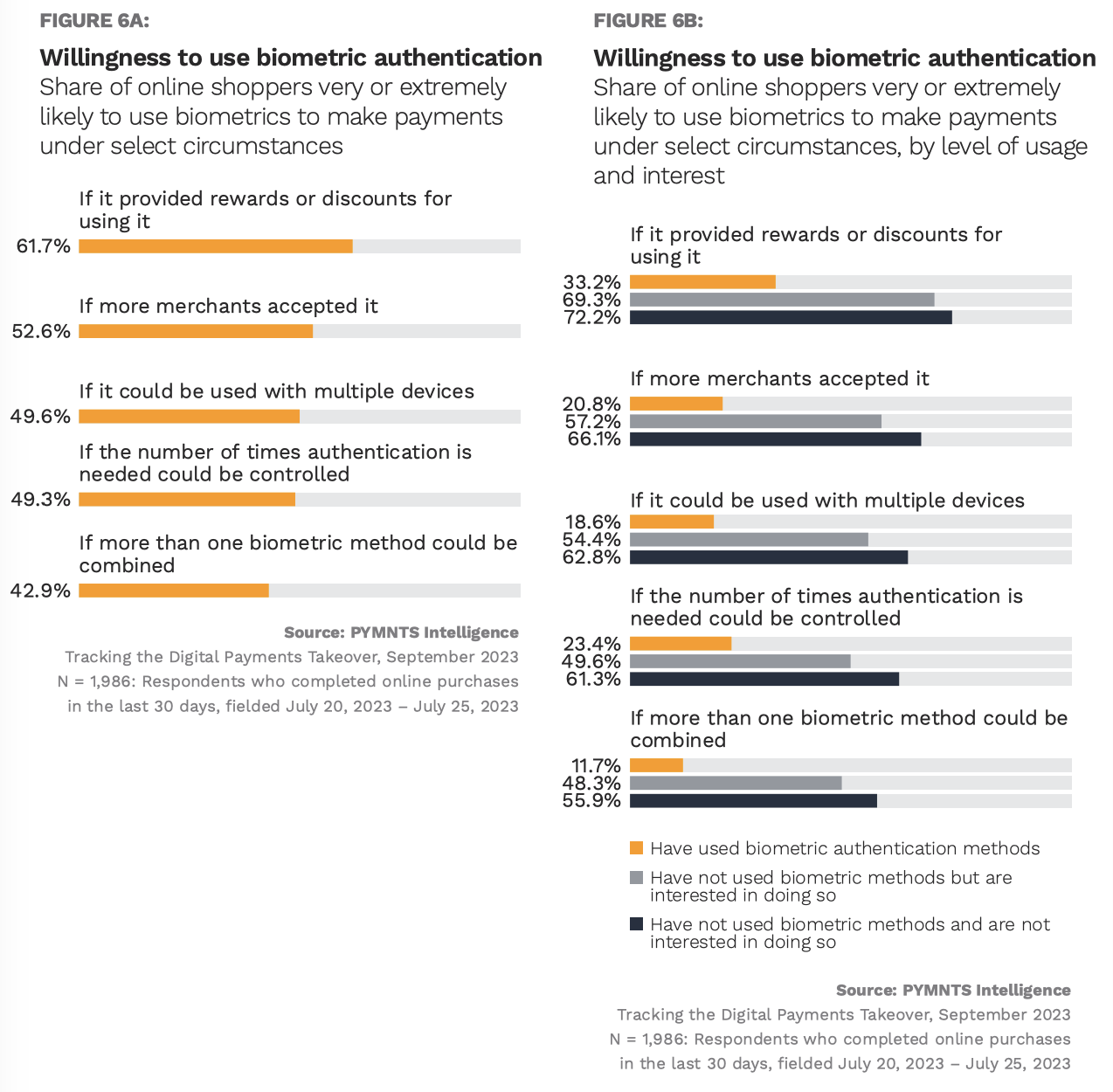
In a digital landscape increasingly defined by the surge of online and mobile shopping, consumer demand for flexible, secure and convenient ways to authenticate transactions is at an all-time high. Enter biometric authentication — a game-changing technology revolutionizing how transactions are verified using unique physical or behavioral traits.
The trend gained serious momentum this year, with an increasing number of individuals, particularly younger generations, hopping on the biometric train as they recognize its value in simplifying and securing transactions.
According to findings detailed in “Biometric Authentication in the Age of Mobile,” a PYMNTS Intelligence and AWS collaboration, more than half of consumers who completed online purchases used biometric authentication to validate their transactions, eliminating the need to remember passwords, scan QR codes or enter credit card information.

The top biometric methods used by nearly 30% and 50% of consumers, respectively, were facial recognition and fingerprint scans. And with nearly 60% of facial recognition users using the method more than once weekly, retailers around the world are capitalizing on this trend.
Mastercard and NEC, for instance, have joined forces to bring biometric checkout to the Asia Pacific region, while French retail giant Carrefour is rolling out facial biometric verification in its franchise stores in the United Arab Emirates. Casual dining chain Steak ‘n Shake is also deploying pay-by-face technology at select restaurants and plans to extend this feature to 300 of its establishments globally.

Commenting on the broader adoption of biometric systems in a November interview, Entersekt Chief Strategy Officer Dewald Nolte told PYMNTS that “people are getting used to logging into their favorite apps on their smartphones using biometrics daily, … and those [kinds] of wallets using biometrics to activate that payment [are] fairly well adopted in the market.”
He added that as biometric authentication adoption gains traction and expands across use cases, eCommerce payments stand out as strong candidates to drive widespread biometric use.
“There are a number of solutions in the market,” Nolte pointed out, “and they are working sufficiently well that they’re mainstream.”
2023 also saw the popularity of biometric tools extending beyond retail shopping to driving commerce in the car.
Mercedes Benz, one of the automakers driving this trend, launched a fingerprint biometric feature enabling users in Germany to authenticate payments directly from their vehicles. The feature, according to Mercedes pay CEO Nico Kersten, helps streamline authentication, especially considering the multiple steps imposed by the European regulation for electronic payment services (PSD2).
“Two-factor authentication,” he told PYMNTS’ Karen Webster, “is good for customer protection, but unfortunately it’s not so good when it comes to customer experience. So that’s why we’ve used biometrics to authenticate payments.”
Biometric payment cards — what Michel Roig refers to as contactless 2.0 — also made a comeback in Europe in 2023.
According to Roig, president of payment and access at Swedish biometrics company Fingerprint Cards, these cards are set to elevate the user experience, offering a seamless way for consumers to verify payment transactions, irrespective of the amount, with a single press of their finger.
“You’re just adding your finger to the sensor, you tap and pay and off you go … It’s an improvement [from standard contactless cards],” he told PYMNTS in March, adding that the ability to remove transaction limits and standardize payment requirements across markets is core to biometrics’ appeal.
However, the significant barrier posed by high costs must be surmounted for biometric card payments to really ignite and reach critical mass, Roig acknowledged, especially among financial institutions (FIs) that do not yet see biometrics as a “revenue generator.”
Additionally, eliminating friction from the enrollment process will be crucial for biometric cards to go mainstream. However, Roig was optimistic, stating: “We’re working to [create] a frictionless, almost zero-cost enrollment journey … and when that final barrier is broken down, there’ll no longer be any hurdles [to adoption].”
The fact that not all consumers have embraced the appeal of biometrics is another hurdle to overcome. Resistance is particularly high among older generations, with 84% of baby boomers and seniors having never attempted using biometric authentication, possibly due to unfamiliarity or a preference for manual data entry. Meanwhile, nearly one in five Generation Z users are steering clear of the technology due to worries about identity theft.
Offering rewards or discounts seems to be an effective way to win over these skeptics. Per the study, 72% would consider trying biometrics logins if given incentives, and a third of previous users would also be swayed by such offers.

Beyond just driving the widespread adoption of biometric authentication tools, striking a healthy balance between convenience and protecting individual privacy and data remains a critical point of discussion in the evolving biometrics landscape.
Around the world, concerns about privacy and human rights violations have sparked renewed debates about this technology, intensifying global demands for stricter regulations and limitations.
China, for instance, introduced draft regulations this summer aimed at imposing limitations on facial recognition, while in the U.K., a group of lawmakers called for an immediate ban on live facial recognition surveillance on U.K. streets by both the police and private companies in October.
Similarly, the United States is taking steps to address ethical and privacy concerns. In a bipartisan move, senators recently proposed legislation to halt involuntary facial recognition screenings at airports, citing worries about privacy and the storage of travelers’ biometric data.
These developments highlight the growing concerns around the world regarding the use of biometrics and its impact on privacy and civil liberties. And as its adoption speeds up across various sectors, the upcoming year is poised to bring more advancements and shifts as more merchants, FIs and non-retail entities embrace biometric technology and grapple with its implications.